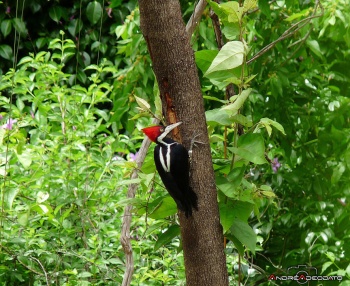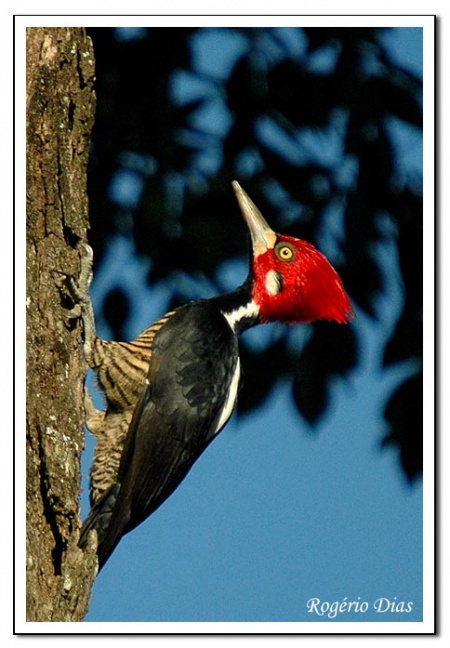(Attempt to disguise some copied text. Taxonomy expanded. References) |
(GSearch expanded) |
||
| (2 intermediate revisions by 2 users not shown) | |||
| Line 9: | Line 9: | ||
====Subspecies==== | ====Subspecies==== | ||
[[Image:Crimson-crested_Woodpecker_female_by_André_Adeodato.jpg|thumb|350px|right|Female, demonstrating the V on the back<br />Photo by '''[http://www.birdforum.net/gallery/member.php?uid=76771 André Adeodato]''' <br /> [[Brazil]], February 2009<br /> (click on image to view larger version) ]] | [[Image:Crimson-crested_Woodpecker_female_by_André_Adeodato.jpg|thumb|350px|right|Female, demonstrating the V on the back<br />Photo by '''[http://www.birdforum.net/gallery/member.php?uid=76771 André Adeodato]''' <br /> [[Brazil]], February 2009<br /> (click on image to view larger version) ]] | ||
| − | + | Three subspecies are recognized<sup>[[#References|[1]]]</sup>: | |
*''C. m. malherbii'': | *''C. m. malherbii'': | ||
:*Western [[Panama]] to northern and central [[Colombia]] | :*Western [[Panama]] to northern and central [[Colombia]] | ||
*''C. m. melanoleucos'': | *''C. m. melanoleucos'': | ||
:*[[South America]] east of Andes to north-eastern [[Argentina]] and [[Brazil]]; winters in [[Trinidad]] | :*[[South America]] east of Andes to north-eastern [[Argentina]] and [[Brazil]]; winters in [[Trinidad]] | ||
| + | *''C. m. cearae'': | ||
| + | :*Northeastern [[Brazil]] (Maranhão to Ceará and Bahia) | ||
| − | |||
==Habitat== | ==Habitat== | ||
Forests and more open woodland, gallery forest, always in lowland and mostly humid to wet. | Forests and more open woodland, gallery forest, always in lowland and mostly humid to wet. | ||
| Line 24: | Line 25: | ||
They can make quite large holes in trees during their search for insects and larvae. The also eat berries. | They can make quite large holes in trees during their search for insects and larvae. The also eat berries. | ||
==References== | ==References== | ||
| − | #{{Ref- | + | #{{Ref-Clements6thOct22}}#Avibase |
#bjornolesen | #bjornolesen | ||
{{ref}} | {{ref}} | ||
==External Links== | ==External Links== | ||
| − | {{GSearch| | + | {{GSearch|"Crimson-crested Woodpecker" {{!}} "Crimson-crested Woddpecker"}} |
| + | {{GS-checked}}<br /><br /> | ||
[[Category:Birds]] [[Category: Campephilus]] | [[Category:Birds]] [[Category: Campephilus]] | ||
Latest revision as of 23:07, 29 September 2023
- Campephilus melanoleucos
Identification
It is identified by the white stripe running down the side of its neck and forming a V on its black back. Its underparts are buff barred with black.
The male has an almost totally red head with a black and white spot on the cheek while the female has the broad white stripe extending from the side of the neck across the cheek to the bill and black front extending back on the crown.
Distribution
Central and South America: found in Panama and Trinidad to Argentina (east of the Andes).
Taxonomy
Subspecies

Photo by André Adeodato
Brazil, February 2009
(click on image to view larger version)
Three subspecies are recognized[1]:
- C. m. malherbii:
- C. m. melanoleucos:
- South America east of Andes to north-eastern Argentina and Brazil; winters in Trinidad
- C. m. cearae:
- Northeastern Brazil (Maranhão to Ceará and Bahia)
Habitat
Forests and more open woodland, gallery forest, always in lowland and mostly humid to wet.
Behaviour
Breeding
The two white eggs are laid in a nest hole in a dead tree. Both adults incubate the eggs.
Diet
They can make quite large holes in trees during their search for insects and larvae. The also eat berries.
References
- Clements, J. F., T. S. Schulenberg, M. J. Iliff, T. A. Fredericks, J. A. Gerbracht, D. Lepage, S. M. Billerman, B. L. Sullivan, and C. L. Wood. 2022. The eBird/Clements checklist of Birds of the World: v2022. Downloaded from https://www.birds.cornell.edu/clementschecklist/download/
- Avibase
- bjornolesen
Recommended Citation
- BirdForum Opus contributors. (2024) Crimson-crested Woodpecker. In: BirdForum, the forum for wild birds and birding. Retrieved 24 June 2024 from https://www.birdforum.net/opus/Crimson-crested_Woodpecker
External Links
GSearch checked for 2020 platform.




